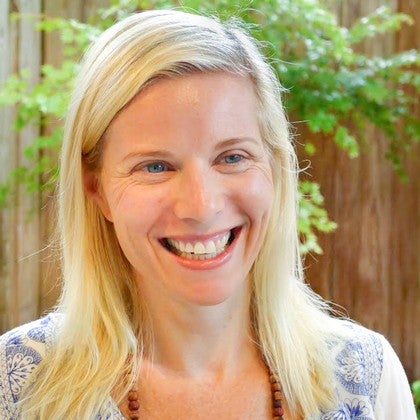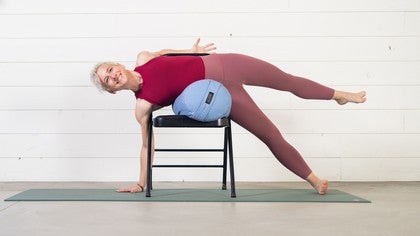
Yoga for Athletes
If you are an athlete – you’re a total jock with sinewy appendages, perfect aim, and undeniable stamina – then count your blessings and read on. If you struggle to see yourself as an athlete, consider claiming something you do in your life as "athletic", whether it be walking the dog, gardening, or climbing stairs. No matter your "sport", our bodies have the most amazing capabilities to run and jump and lift and swim. And your body wants you to know this: yoga can help you.
I have a friend who is both a personal trainer and yoga teacher, so she witnesses daily the benefits of adding yoga into an athletic lifestyle. But, she laments, it’s a stealthy endeavor to convince most of her athletic clients to cross the forbidden line and venture onto a yoga mat.
I asked her why she thought this was the case. “Athletic minds like structure,” she explained.
She went on to clarify that most yoga classes don’t have the kind of incentive-based and goal-oriented protocol that seems to entice athletes. One could certainly argue that Hot Yoga and it’s 26-pose repertoire exhibits structure. Traditional Ashtanga Vinyasa also offers the different stages - beginning with the Primary Series - that might lure a mind craving a goal-driven framework. But these more athletic styles of yoga are not always what an athlete actually needs from a yoga class.
Most athletes don’t require more athleticism – more charge or more drive. They need to calm their systems down and release the pressure valve. Athleticism deliberately creates tension in the body, and athletes need to balance this artful creation of tightness with a thoughtful surrendering to slackness from time to time.
I’m not implying that tension is bad. Although it often has a negative connotation, tension is a necessary part of our physical systems. To jump and balance and lift heavy things, our bodies require a certain amount of muscular tautness. This useful tension stabilizes and protects our joints, keeping our spines, knees, or shoulders safe while training. The problem is, with athletes, this tension is often overbearing.
I once had a yoga student who was a young, remarkable tennis player. He competed and taught private lessons to wealthy clients, walking in the door of the studio for the first time with tanned skin and rippling muscles. But when he took my class, he was pitiful. Forget touching his toes, he could barely tip forward at the hips without grimacing. His body was beyond taut; it had become rigid. As his body vibrated with the release of tension in a simple stretch, it was obvious he was embarrassed. He was the only student in the room lying on his back with one foot in a strap visibly and uncontrollably shaking. Clearly, he hadn’t expected yoga to be this strenuous.
I have never forgotten this student because he is a marker for me. He showed me that bravery is a requirement in the process of maintaining physical health. It’s humbling to be inexperienced at something no matter what your age; but this is particularity true if you are an adult - and undeniably true if you are an athlete used to being exceptional at physical endeavors.
Trying something new can make us feel like a fool. There is no denying this. But we must expand our comfort zone to embrace both the yin and the yang of fitness if we want to achieve optimal performance from our bodies. We want the body to be stable, but we don’t want the body to be over-stabilized. If we have too much tension in the system, injury has the chance to swoop in like the predator that it is; and once injury sinks its grip into our bodies, it often clamps down and won’t release until we release.
Enter yoga: a practice to help us release.
Yoga allows within us an unbinding. When we allow our tissues to yield, we allow the whole body to relax and reintegrate. We let go and relax; we sit back and enjoy the ride while the body realigns itself, trusting in the body’s innate wisdom. Yoga teaches us when not to push the body; when to just let it unravel.
My yoga teacher/personal trainer friend reports that she has seen eye-popping progress in her clients when they accommodate a yoga session as part of their weekly routine. Most of her athletic clients are exceptionally tight in the legs, hips, and glutes. Particularly the quadriceps – the group of muscles on which she first shines her yoga flashlight. By illuminating her clients on the excruciating tightness in the front of their thighs, the relief from a simple quad stretch can often entice her clients to see yoga in a whole new light: as another “workout” that can enhance their wellbeing.
If you are athletic and are new to yoga, give yourself some structure and purpose. Perhaps start with a few stretches for the legs and hips. Poses like Reclining Butterfly or Legs Up the Wall or the lunge stretch of Lizard Pose could be helpful poses to get you started. There are certainly modifications for more challenging stretches like Pigeon Pose or Half Saddle Pose.
Basically, just gather a handful of poses – not too many to overwhelm – and try and hold the poses for 10 to 30 seconds to begin with. Set a timer while stretching and eventually see if you can progress to longer pose holds – maybe even up to 3 minutes - so that your system can truly release and you can move beyond the initial stress of pulling on those tight muscles. Once you can breathe calmly in a stretch, you will know you are making progress and your mind will become still enough that you can actually feel your internal tissues relaxing and yielding. Tension melts away, which has a luxuriously calming effect on the mind.
Bottom line, if you are athletic, which I believe it is truly wise for all of us to be in our own way, then your body will perform at its most optimal level by incorporating the balance of something along the lines of yoga. And while it may be humbling at first, I can promise that once you get past the initial awkwardness, the physical benefits of stretching, the centering advantages of breathwork, and the mental rewards of meditation will wash over you. You will find yourself actually craving the counterbalancing tonic of a regular yoga practice. Yes, even you.
Comments
No comments yet. Be the first!








You need to be a subscriber to post a comment.
Please Log In or Create an Account to start your free trial.